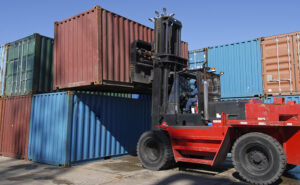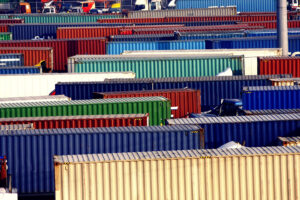Clear, consistent communication is crucial for container yard optimization
By Kenneth Saunders
If your container terminal has a congestion problem, that is a good thing. It is an indicator that business is thriving. However, port managers do need to run their operation as efficiently as possible so as to better serve customers and to maximize profits.
 While terminal congestion is a problem with positive connotations, it creates obstacles that have to be overcome. Optimal use of the container yard yields the greatest results.
While terminal congestion is a problem with positive connotations, it creates obstacles that have to be overcome. Optimal use of the container yard yields the greatest results.
Congestion is typically caused by capacity limitations and related issues. In some cases, a port may be too small. Additionally, problems such as bottlenecks (due to insufficient container storage space) often arise. All these issues could individually or collectively lead to an increase in long-stay containers on the terminal.
Customers not collecting containers in a timely manner, thus creating a backlog is also a likely scenario . Similarly, terminals may find themselves storing transshipment containers, for longer than is optimal, creating congestion and excessive yard shifts. Both problems hinder production and increase operation costs.
Crucial
Clear and consistent communication between port and shipping line is crucial for surmounting obstacles to container yard optimization.
Port managers should have regular meetings with the lines to discuss operations, expressing objectives, expectations and issues that arise. Routine follow-up communication via email or telephone is also essential.
 Effective communication with gate customers can mean coordinating with them to get containers out of the yard as quickly as possible. On the transshipment side, it can mean arranging to shift containers from ship side, while ensuring that longer stay containers are scheduled to be removed from the terminal swiftly. Containers may also be positioned as close as possible to the berth where they are to be loaded, to ensure shorter runs and improved crane productivity. Information as to when containers are leaving the terminal would certainly allow for improved planning of efficient container positioning.
Effective communication with gate customers can mean coordinating with them to get containers out of the yard as quickly as possible. On the transshipment side, it can mean arranging to shift containers from ship side, while ensuring that longer stay containers are scheduled to be removed from the terminal swiftly. Containers may also be positioned as close as possible to the berth where they are to be loaded, to ensure shorter runs and improved crane productivity. Information as to when containers are leaving the terminal would certainly allow for improved planning of efficient container positioning.
Improved transparency in communication with the line operators can mean ascertaining the timing of containers moving in and out of terminals. If both shipping lines and ports want good productivity, there must be better coordination between those parties.
Flexible berth planning
 Flexible berth planning provides another form of yard optimization. Berthing arrangements that allow for shorter run distances facilitate better crane productivity on vessels. Clear communication on which containers are to be offloaded or loaded onto which vessels makes for solid planning for short runs between the locations.
Flexible berth planning provides another form of yard optimization. Berthing arrangements that allow for shorter run distances facilitate better crane productivity on vessels. Clear communication on which containers are to be offloaded or loaded onto which vessels makes for solid planning for short runs between the locations.
If vessel arrivals are delayed for one reason or other, ports should have the ability to recommend changes in berths for better productivity. This requires that shipping lines be flexible as well. Both parties can work towards this flexibility if ports are proactive about providing clear explanations and expectations as to what will or could happen when a particular scenario is presented.
Terminals need to have more flexibility in choosing the cargo that can be loaded rapidly and efficiently based on proximity and convenience to a vessel. If certain containers are located nearer to where a ship will be berthed, the port can offer a list of such containers and have the line determine which ones it would like to have loaded.
As for smaller terminals, using similar transparency in communication will support and facilitate better management of resources. Small terminals can maximize equipment fuel consumption through shorter run distances. They can also reduce labour and shift hours within a yard through clear and timely communication between terminal and line. Transparency in communication can also allow for lead time in scheduling additional labour to prepare for last minute changes. Containers may be arranged to shorten move-distances, thereby increasing productivity on vessel operations.
Improvisational thinking will go a long way in yard optimization. When space is the challenge, terminals have to be creative and flexible: creating space by utilizing every inch of the terminal that is within bounds, in ways that do not compromise safety or create obstructions.
Terminals should always have a contingency plan. Such plans help to ensure the optimization of the yard regardless of the unexpected. []
- First published December 1, 2022

- Kenneth Saunders is a specialist in seaport productivity and revenue generation at kennethsaundersconsulting.com.





